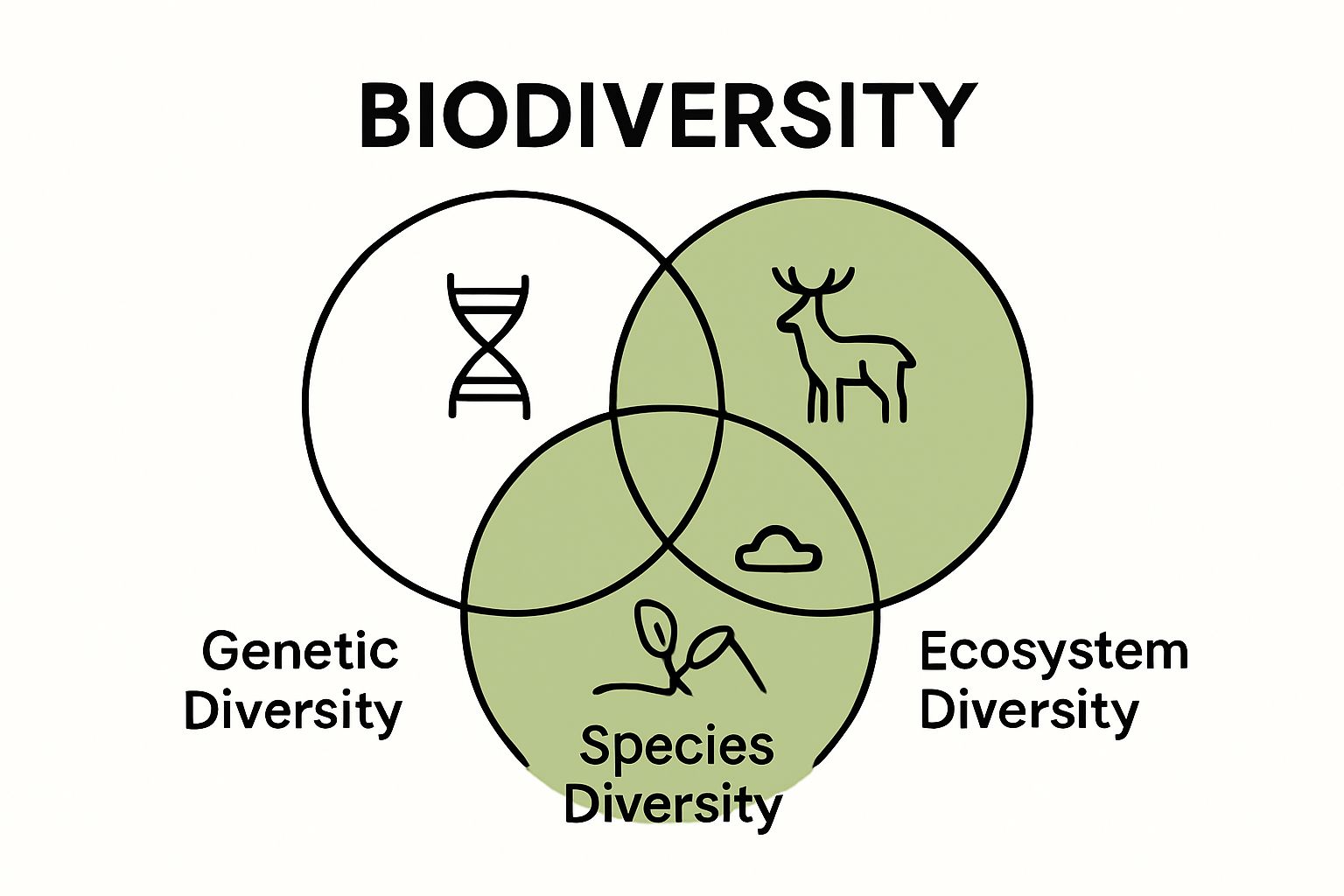Biodiversity is often described as the backbone of life on Earth, supporting everything from the food on your plate to the stability of entire ecosystems. Yet, farms that support higher biodiversity see crop yields that are 20-30% more stable than those with monocultures. Most people expect technology or fertilizers to play the starring role in farming success, but it turns out the secret ingredient is the unseen variety of life hiding in the soil and fields.
Table of Contents
- What Is Biodiversity And Its Role In Ecosystems
- Why Biodiversity Is Crucial For Agriculture And Livestock
- How Biodiversity Impacts Soil Health And Crop Yield
- The Relationship Between Biodiversity And Climate Resilience
- Real-World Examples Of Biodiversity Benefits In Farming
Quick Summary
| Takeaway | Explanation |
|---|---|
| Biodiversity enhances farm resilience | Diverse ecosystems can better withstand environmental stresses, promoting stability in crop yields. |
| Genetic diversity safeguards against failures | Maintaining a variety of crops and livestock reduces risk of loss from diseases or climate change. |
| Healthy ecosystems improve soil fertility | Interactions among diverse microorganisms enhance nutrient availability and soil structure, benefiting plant health. |
| Integrated pest management reduces chemical use | Encouraging biodiversity can lower reliance on pesticides, leading to more sustainable farming practices. |
| Polyculture increases overall productivity | Using diverse planting systems can boost agricultural output significantly compared to monoculture methods. |
What is Biodiversity and Its Role in Ecosystems
Biodiversity represents the incredible variety of living organisms that exist on our planet, encompassing the intricate web of life spanning multiple levels from genetic diversity within species to the complex interactions between different species and their environments. This remarkable tapestry of life plays a fundamental role in maintaining ecological balance and supporting agricultural systems worldwide.
Understanding Biodiversity’s Core Components
At its most fundamental level, biodiversity consists of three primary dimensions: genetic diversity, species diversity, and ecosystem diversity. Genetic diversity ensures that individual species can adapt and survive changing environmental conditions.
 Species diversity represents the total number of different species within a particular habitat, while ecosystem diversity encompasses the variety of habitats, ecological communities, and environmental processes across landscapes.
Species diversity represents the total number of different species within a particular habitat, while ecosystem diversity encompasses the variety of habitats, ecological communities, and environmental processes across landscapes.
According to National Geographic, biodiversity is not just about counting species but understanding the complex relationships and interdependencies that allow ecosystems to function effectively. For agricultural settings, this means recognizing that every organism plays a critical role in maintaining overall system health and productivity.
Below is a table breaking down the core components of biodiversity, summarizing each type and its relevance in agricultural ecosystems.
| Component | Definition | Agricultural Role |
|---|---|---|
| Genetic Diversity | Variability in genes within a species | Enables crops and livestock to adapt to changing conditions |
| Species Diversity | Variety and abundance of different species in a habitat | Supports ecological balance and multiple ecosystem services |
| Ecosystem Diversity | Assortment of habitats, ecological communities, and environmental processes | Maintains system stability and diverse production landscapes |
Ecological Interactions and Agricultural Significance
Biodiversity functions like an intricate, living network where each organism contributes to maintaining environmental stability. In farm ecosystems, this translates into multiple critical functions:
- Soil microorganisms decompose organic matter and cycle nutrients
- Pollinators like bees and butterflies enable crop reproduction
- Predatory insects help control pest populations naturally
- Different plant species prevent soil erosion and enhance soil structure
Research from The Ecological Society of America demonstrates that farms with higher biodiversity experience more resilient agricultural systems. These diverse environments can better withstand environmental stresses, recover from disturbances, and maintain consistent productivity compared to monoculture landscapes.
By understanding biodiversity’s profound significance, farmers and land managers can develop strategies that support and enhance ecological complexity, ultimately creating more sustainable and productive agricultural environments.
Why Biodiversity is Crucial for Agriculture and Livestock
Biodiversity serves as the foundational framework that enables agricultural systems to thrive, adapt, and remain resilient in the face of environmental challenges. Beyond merely supporting plant and animal life, biodiversity creates a complex ecological infrastructure that directly impacts farm productivity, sustainability, and long-term economic viability.
Genetic Resilience and Adaptation Mechanisms
Genetic diversity within agricultural species provides critical defense mechanisms against environmental stresses. Farmers who maintain diverse crop varieties and livestock breeds create natural insurance against potential crop failures or disease outbreaks. Different genetic profiles mean some plants or animals will inherently possess stronger resistance to specific environmental challenges, whether those are drought conditions, temperature fluctuations, or emerging pathogen threats.
Research from Food and Agriculture Organization highlights that agricultural systems with higher genetic diversity demonstrate remarkable capacity to withstand and recover from environmental disruptions. This genetic variability allows for continuous adaptation and evolution, ensuring agricultural systems remain dynamic and responsive to changing conditions.
Ecological Support Systems and Productivity
Biodiversity creates intricate ecological networks that directly enhance agricultural productivity. These networks involve complex interactions between organisms that provide essential services:
- Natural pest control through predatory insect populations
- Soil fertility maintenance by diverse microorganism communities
- Pollination services from multiple insect and animal species
- Enhanced nutrient cycling and organic matter decomposition
According to Nature Research, farms maintaining robust biodiversity experience approximately 20-30% more stable crop yields compared to monoculture agricultural systems. This stability stems from the interconnected ecological support mechanisms that buffer against environmental variations.
By understanding sustainable farming practices, farmers can develop strategies that intentionally promote and preserve biodiversity. This approach transforms agricultural landscapes from simple production zones into complex, self-regulating ecosystems that are more resilient, productive, and environmentally sustainable.
How Biodiversity Impacts Soil Health and Crop Yield
Soil represents a living ecosystem where biodiversity plays a critical role in determining agricultural productivity. The intricate interactions between microorganisms, plants, insects, and organic matter create a complex network that directly influences soil fertility, nutrient availability, and ultimately crop performance.
Microbial Diversity and Nutrient Cycling
Soil microorganisms form the foundation of agricultural ecosystem health, performing essential functions that enable plant growth and soil regeneration. These microscopic organisms break down organic matter, transform nutrients, and create symbiotic relationships with plant roots. Different microbial species specialize in specific nutrient transformations, ensuring a comprehensive and efficient nutrient cycling process that supports robust crop development.
Research from Nature Plants demonstrates that soils with higher microbial diversity exhibit enhanced nutrient availability, improved soil structure, and increased resistance to environmental stresses. These microorganisms act as natural fertilizers, reducing the need for synthetic agricultural inputs and promoting more sustainable farming practices.

Ecological Interactions and Soil Structure
Biodiversity creates a complex web of interactions that directly enhance soil physical properties and crop productivity. These ecological relationships manifest through multiple mechanisms:
- Root systems from diverse plant species create varied soil channels
- Different organisms contribute to organic matter decomposition
- Predatory microbes help control potentially harmful soil pathogens
- Complex root networks improve soil aeration and water retention
According to Frontiers in Plant Science, agricultural landscapes with higher plant and microbial diversity demonstrate more resilient soil ecosystems. These diverse systems can better withstand environmental fluctuations, maintain consistent nutrient availability, and support more stable crop yields.
By understanding building windbreaks for agriculture, farmers can create additional strategies to protect and enhance these delicate ecological interactions. Windbreaks not only protect crops but can also introduce additional biodiversity elements that contribute to overall soil and ecosystem health, creating a more robust and productive agricultural environment.
The Relationship Between Biodiversity and Climate Resilience
Biodiversity serves as a critical adaptive mechanism that enables agricultural ecosystems to respond, survive, and thrive amid increasingly unpredictable climate conditions. By creating complex, interconnected biological systems, farmers can develop natural defense strategies against environmental disruptions and extreme weather events.
Genetic Adaptation and Environmental Flexibility
Agricultural systems with high biodiversity possess inherent climate buffering capabilities that allow for more dynamic responses to environmental challenges. Diverse genetic profiles within crop and livestock populations mean that some individuals will naturally demonstrate greater resistance to temperature shifts, moisture variations, and emerging climatic stressors.
Research from Intergovernmental Panel on Climate Change, indicates that agricultural landscapes maintaining genetic diversity can experience up to 40% less productivity loss during extreme weather events compared to monoculture systems. This genetic variation creates a natural insurance policy against potential crop failures and environmental disruptions.
Ecological Networks and Climate Adaptation
Biodiversity creates intricate ecological networks that enhance climate adaptation through multiple complementary mechanisms:
- Diverse plant species with different root structures improve soil water retention
- Mixed cropping systems reduce vulnerability to single-point environmental failures
- Complex ecosystems provide multiple pathways for nutrient and energy transfer
- Varied biological interactions create more robust environmental responses
According to Global Change Biology, agricultural landscapes with rich biodiversity demonstrate superior capacity to maintain productivity under variable climate conditions. These systems can more effectively redistribute environmental risks and maintain stable food production.
By understanding sustainable farming practices, farmers can intentionally design agricultural landscapes that leverage biodiversity as a strategic climate resilience tool. This approach transforms agricultural systems from passive production zones into adaptive, self-regulating environments capable of withstanding and responding to emerging environmental challenges.
Real-World Examples of Biodiversity Benefits in Farming
Practical demonstrations of biodiversity’s impact reveal powerful strategies that farmers can implement to enhance agricultural productivity, sustainability, and ecosystem health. These real-world examples showcase how intentional biodiversity management transforms traditional farming approaches into more resilient and efficient agricultural systems.
Integrated Pest Management Strategies
Biodiversity serves as a natural pest control mechanism that reduces reliance on chemical interventions. By cultivating diverse plant species and encouraging beneficial insect populations, farmers can create sophisticated ecological defense systems. For instance, planting flowering strips between crop rows attracts predatory insects like ladybugs and lacewings, which naturally control destructive pest populations.
Research from Agricultural Systems Journal demonstrates that farms implementing integrated biodiversity strategies can reduce pesticide usage by up to 60%, while maintaining equivalent crop yields. These approaches not only decrease chemical input costs but also protect long-term soil and environmental health.
Polyculture and Crop Rotation Innovations
Farmers are increasingly adopting sophisticated biodiversity techniques that maximize land productivity and ecological balance:
- Intercropping complementary plant species
- Rotating crops with different nutritional requirements
- Integrating livestock grazing with crop production
- Preserving native plant species alongside agricultural crops
According to Nature Sustainability, polyculture systems can increase overall agricultural productivity by 20-30% compared to traditional monoculture approaches. These methods create more complex, resilient agricultural ecosystems that naturally manage nutrients, control pests, and maintain soil health.
By understanding sustainable water management, farmers can further enhance these biodiversity strategies, creating holistic agricultural systems that balance productivity with environmental stewardship. These integrated approaches demonstrate that biodiversity is not just an ecological concept, but a practical, economically viable farming strategy.
The following table compiles key research statistics from the article to clearly present biodiversity’s impact on farm productivity and sustainability.
| Research Finding | Statistic/Result | Source/Section |
|---|---|---|
| Crop yield stability in biodiverse vs. monocultures | 20-30% more stable yields | Introduction, Nature Research |
| Reduction in pesticide use with integrated biodiversity | Up to 60% reduction | Integrated Pest Management |
| Productivity loss during climate events (biodiverse farms) | Up to 40% less productivity loss | IPCC, Climate Resilience |
| Productivity increase with polyculture versus monoculture | 20-30% higher overall productivity | Polyculture Innovations |
Transform Farm Biodiversity Into Lasting Productivity with FenceFast
You have worked hard to nurture your farm’s biodiversity, understanding how crucial diverse plant and animal life is for soil health, crop yield, and climate resilience. Yet many rural communities face ongoing challenges, such as protecting this ecological balance from livestock pressure, predator encroachment, or inefficient animal management tools. Without the right support systems, it can be difficult to create sustainable, thriving ecosystems on your land.
FenceFast.ca helps bridge the gap between ecological knowledge and practical farming needs. Our wide selection of animal management tools and fencing supplies makes it easier to support beneficial ecological interactions described in the article, like natural pest control and improved soil structure. Equip your operation with quality fencing, livestock monitoring, and safe enclosure solutions designed to preserve habitat variety and protect each unique species on your farm.

Ready to bring your farm’s biodiversity strategies to life? Visit FenceFast.ca today to find trusted products and expert support for resilient and sustainable agriculture. Make the leap now to enjoy healthier soils, happier livestock, and true ecological success.
Frequently Asked Questions
How does biodiversity benefit my farm’s soil health?
Biodiversity enhances soil health by promoting microbial diversity, which is critical for nutrient cycling and soil structure. To improve your farm’s soil health, consider planting diverse crop varieties to naturally enhance microbial communities and boost fertility over time.
What are effective practices to increase biodiversity on my farm?
Effective practices include implementing crop rotation, polyculture, and integrated pest management strategies. Start by intercropping different plant species and establishing flowering strips to attract beneficial insects, which can increase farm productivity and sustainability.
How can I use biodiversity to manage pests naturally?
You can manage pests by encouraging diverse plant species and beneficial predators, such as ladybugs and lacewings, on your farm. Planting flowering plants between crop rows can attract these insects, helping you reduce pesticide use by up to 60% while maintaining healthy yields.
What role does genetic diversity play in my farm’s resilience?
Genetic diversity allows your crops and livestock to better withstand environmental stresses, such as drought or disease. To boost resilience, maintain a variety of crop and livestock breeds that have different traits, providing a natural safety net against potential failures.
How can I measure the impact of biodiversity on my farm’s productivity?
You can measure productivity impacts by comparing crop yields from biodiverse practices versus monoculture methods. Monitor your yields over a growing season; farms using diverse strategies often experience 20-30% more stable yields compared to those with less biodiversity.
What are the signs of improved biodiversity on my farm?
Signs of improved biodiversity include enhanced soil health, increased presence of beneficial insects, and healthier crop growth. Track these indicators regularly and aim for visible changes within a single growing season to verify the effectiveness of your biodiversity strategies.
